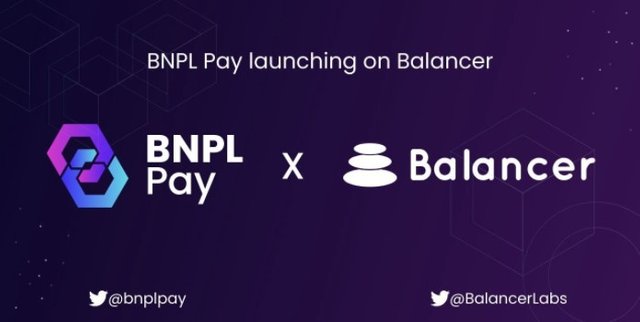DeFi Lending Platform BNPL Pay to Conduct Token Sale on Balancer
The DeFi market was only valued at $1 billion in February 2020, which was right before the start of the COVID-19 outbreak. After most major financial markets crashed in March 2020, they quickly recovered including the crypto and nascent DeFi space. Available data shows that the DeFi ecosystem is valued at nearly $100 billion at the time of writing.
This year has definitely been centered around the rise of DeFi apps, a fast-evolving sector that has maintained impressive growth in 2021, despite Bitcoin and Ethereum (and altcoin) prices crashing briefly during the summer months.
With the emergence of DeFi platforms, Ethereum (ETH) has decisively dominated the decentralized lending markets. Meanwhile, other blockchain or distributed ledger technology (DLT) platforms such as Binance Smart Chain (BSC), Solana (SOL), and THORChain have been trying to compete for market share.
BNPL Pay to Enable Financial Inclusion
There are a number of high-potential DeFi initiatives that are taking advantage of the hot market right now. They’ve introduced different types of apps across a wide range of blockchain or DLT-based networks.
BNPL (or Buy Now, Pay Later) Pay is one such relatively new initiative that may be considered a promising part of the THORChain ecosystem. The DeFi lending protocol allows users to access funds through uncollateralized borrowing.
The BNPL Pay protocol is set to carry out its initial IDO via the Thorstarter Launchpad on September 14, 2021.
Additional Token Sale to Launch on Balancer’s Liquidity Bootstrapping Pool
The project will also conduct its public sale of 55M tokens through Balancer’s Liquidity Bootstrapping Pool on September 16, 2021.

Liquidity Bootstrapping Pools (LBPs) on Balancer are basically Smart Pools (also referred to as Configurable Rights Pools). As explained in the Balancer project documentation, a smart pool is a type of contract that’s used to control a Balancer core pool, which carries the digital tokens and is used on the exchange platform.
Unlike immutable (or unalterable) shared pools, smart pool controllers have the ability to change the parameters of the pool, but this can be done in a controlled way. This is the reason why it’s “less trustless” than a shared pool, however, it doesn’t require the full trust of a private pool.
The idea behind an LBP is to provide a crypto token with fairly low capital requirements, by forming a two-token pool with a particular project along with a collateral token.
At first, the weights are set in favor of the project token, and then "flipped" in favor of the collateral coin when the sale is concluded. The sale can be calibrated to ensure that the price stays “more or less steady (maximizing revenue), or declining to a desired minimum (e.g., the initial offering price).”
BNPL Rising in Popularity
BNPL has become a popular sales and business strategy that enables consumers to provide capital they want to lend in order to serve as a banking node. The BNPL protocol is supported by a decentralized network of centralized banking nodes, with each of these nodes offering lending services to entities seeking affordable loans, but without having to provide collateral.
Major DeFi projects such as AAVE and Compound have become key players in the decentralized lending market. However, they’ve not been able to effectively provide reliable credit solutions to the financially underserved consumers.
The BNPL Pay platform aims to offer dependable lending services to marginalized communities who have struggled to acquire loans via the traditional platforms. Although other initiatives have tried to provide similar services, they’ve not been successful at offering dependable services.
According to the BNPL team, their protocol has been specifically designed to lower the risks by increasing the number of borrowers and offering them services through centralized banking nodes within their decentralized network.
BNPL Pay is reportedly based on a competitive mechanism, which makes entities that maintain banking nodes compete with each other for capital from lenders and for providing loans to prospective borrowers.
The incentivization scheme used in the DAO has been developed to make sure that node operators are properly rewarded with a certain percentage of interest accumulated within the pool. Meanwhile, the staked tokens can get slashed in case funds are lost.